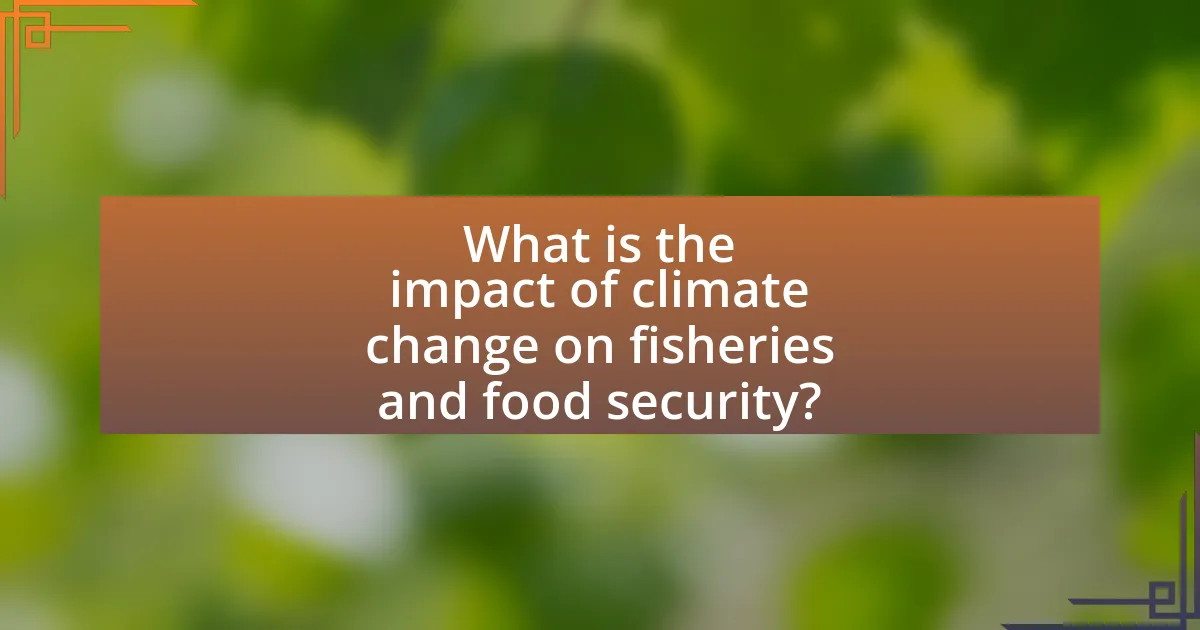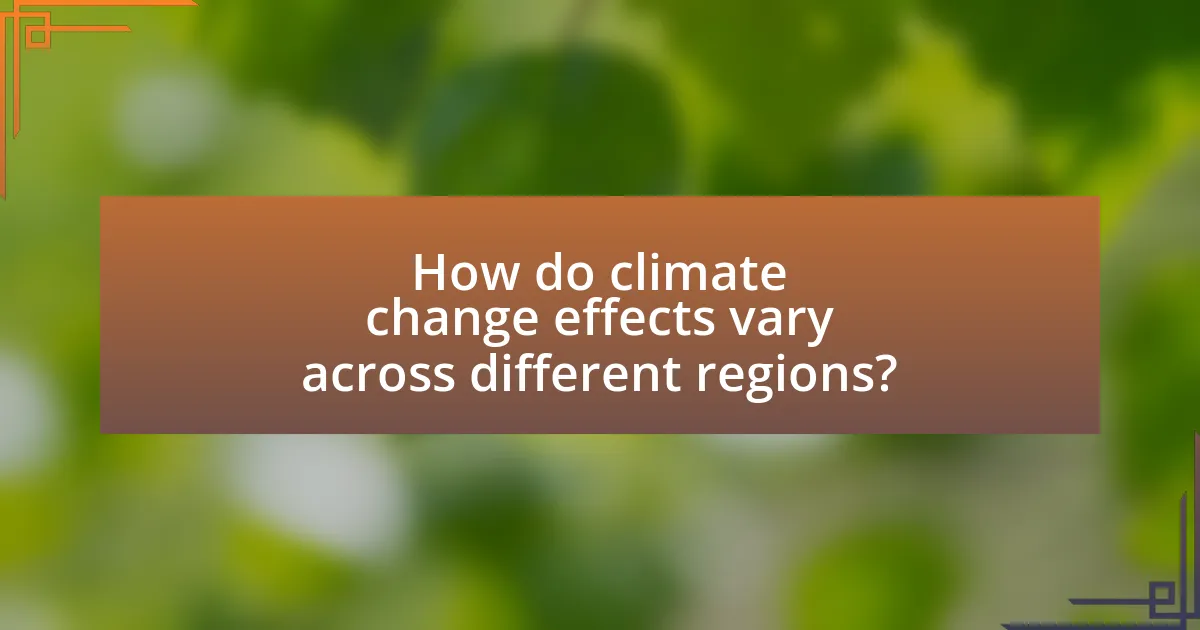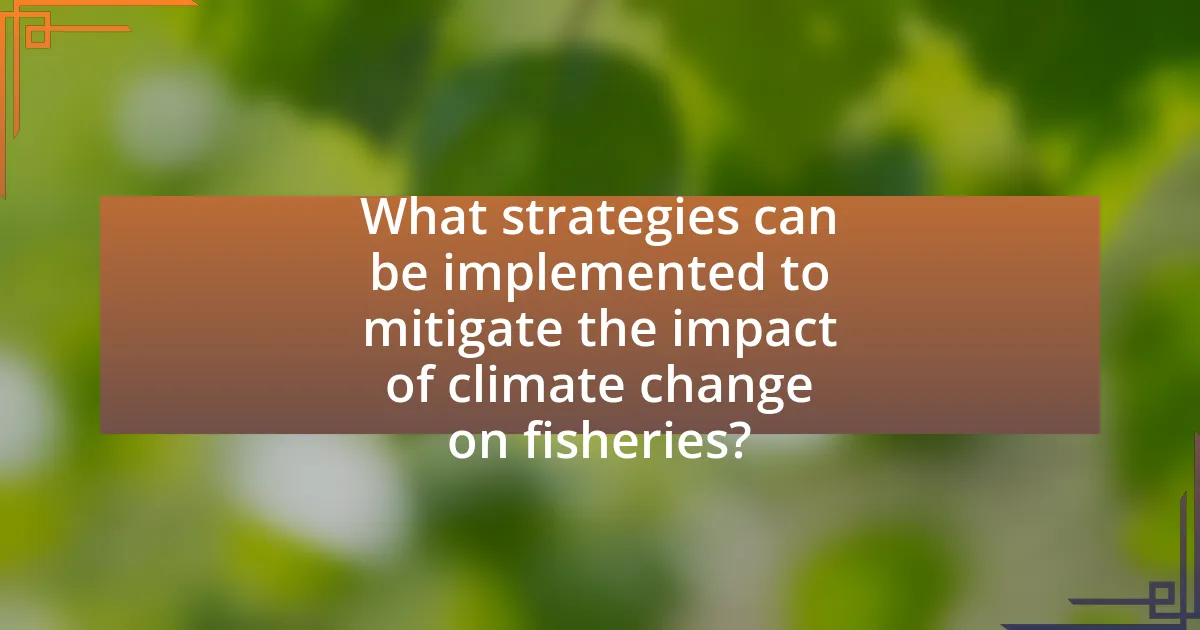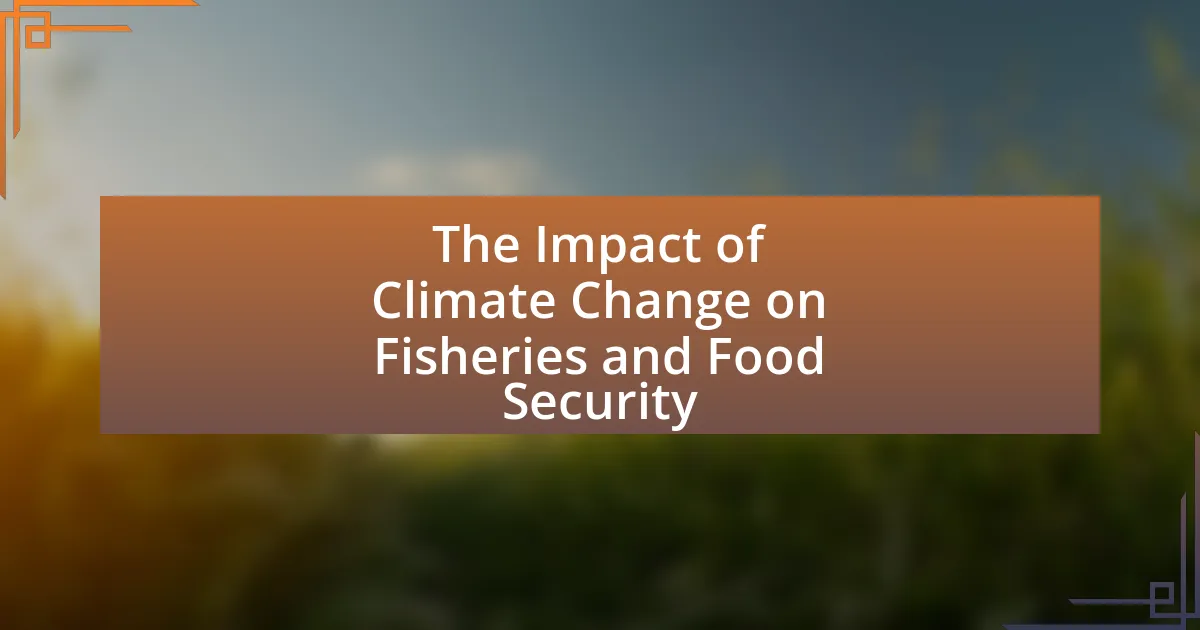The article examines the significant impact of climate change on fisheries and food security, highlighting how rising ocean temperatures, ocean acidification, and altered marine ecosystems threaten fish populations and the livelihoods of communities dependent on them. It discusses the implications of declining fish stocks for nutrition, particularly in developing nations, and the economic consequences for fishing communities. The article also explores regional variations in vulnerability to climate change, the role of local fishing practices in enhancing resilience, and strategies for mitigating these impacts through sustainable management and policy frameworks. Overall, it underscores the urgent need for adaptive measures to ensure food security and the sustainability of fisheries in the face of climate change.

What is the impact of climate change on fisheries and food security?
Climate change significantly impacts fisheries and food security by altering marine ecosystems and fish populations. Rising ocean temperatures lead to shifts in species distribution, affecting the availability of fish stocks that communities rely on for nutrition and income. For instance, the Intergovernmental Panel on Climate Change (IPCC) reports that overfishing combined with climate change could reduce global fish catches by 20% by 2050. Additionally, ocean acidification, a direct result of increased carbon dioxide levels, threatens shellfish populations, which are crucial for many coastal communities. These changes jeopardize food security, particularly in developing nations where fish is a primary protein source, highlighting the urgent need for adaptive management strategies in fisheries to mitigate these impacts.
How does climate change affect fish populations?
Climate change negatively affects fish populations by altering their habitats, reproductive patterns, and food availability. Rising ocean temperatures lead to shifts in species distribution, with many fish migrating towards cooler waters, which can disrupt local fisheries. Additionally, ocean acidification, a direct result of increased carbon dioxide levels, impacts fish growth and survival rates. Research indicates that over 30% of fish species are at risk due to these changes, as highlighted in the Intergovernmental Panel on Climate Change (IPCC) report, which emphasizes the vulnerability of marine ecosystems to climate-related stressors.
What specific changes in water temperature influence fish species?
Specific changes in water temperature that influence fish species include increases in temperature, which can lead to altered metabolic rates, reproductive cycles, and habitat suitability. For instance, a rise in water temperature by just 1-2 degrees Celsius can significantly affect species like salmon, which require cooler waters for spawning. Additionally, warmer temperatures can expand the range of some species, such as certain types of tuna, while causing stress or decline in others, like cod, which are sensitive to temperature changes. Studies have shown that as global temperatures rise, fish populations may shift towards cooler waters, impacting local fisheries and food security.
How do altered ocean currents impact fish migration patterns?
Altered ocean currents significantly impact fish migration patterns by changing the distribution of nutrients and temperature gradients in marine environments. These changes can lead to shifts in the availability of prey species and suitable habitats, forcing fish to adapt their migratory routes. For instance, research has shown that the warming of ocean waters and altered currents due to climate change can displace fish populations from traditional spawning grounds, as seen with species like cod and herring in the North Atlantic. This disruption not only affects the fish themselves but also has cascading effects on the entire marine ecosystem and fisheries dependent on these species for food security.
What are the implications of declining fish stocks for food security?
Declining fish stocks significantly threaten food security, particularly for communities reliant on fish as a primary protein source. As fish populations decrease due to overfishing and climate change, the availability of affordable and nutritious food diminishes, leading to increased malnutrition and food scarcity. For instance, the Food and Agriculture Organization (FAO) reports that nearly 3 billion people globally depend on fish for at least 20% of their animal protein intake. Consequently, reduced fish stocks can exacerbate poverty and food insecurity, especially in developing nations where fish is a critical dietary component.
How does reduced fish availability affect nutritional intake in vulnerable populations?
Reduced fish availability negatively impacts nutritional intake in vulnerable populations by decreasing access to essential nutrients found in fish, such as omega-3 fatty acids, protein, and vitamins. Vulnerable populations, often reliant on fish as a primary source of nutrition, face increased risks of malnutrition and related health issues when fish stocks decline. For instance, the Food and Agriculture Organization (FAO) reports that fish provides about 20% of animal protein intake for over 1 billion people globally, highlighting its critical role in food security. Consequently, reduced fish availability can lead to deficiencies in key nutrients, exacerbating health disparities and food insecurity among these populations.
What economic consequences arise from diminished fisheries?
Diminished fisheries lead to significant economic consequences, including reduced income for fishing communities and increased food prices. The decline in fish populations directly impacts the livelihoods of millions who depend on fishing for their income, with estimates indicating that over 200 million people globally rely on fisheries for their primary source of income. Additionally, as fish stocks decrease, the supply of seafood diminishes, resulting in higher prices for consumers. For instance, the Food and Agriculture Organization reported that global fish prices have risen by approximately 30% over the past decade due to overfishing and climate change effects. This combination of reduced income and increased costs can exacerbate food insecurity, particularly in regions heavily reliant on fish as a primary protein source.

How do climate change effects vary across different regions?
Climate change effects vary significantly across different regions due to factors such as geography, climate systems, and socio-economic conditions. For instance, coastal regions experience rising sea levels and increased ocean temperatures, which threaten fisheries and marine biodiversity, while arid regions face intensified droughts, impacting agricultural productivity and food security. According to the Intergovernmental Panel on Climate Change (IPCC) report, regions like sub-Saharan Africa are projected to see a decrease in crop yields by up to 50% by 2050 due to climate change, while Arctic regions are experiencing rapid warming, leading to shifts in fish populations and ecosystems. These regional variations highlight the complex interplay between climate change and local environmental and economic contexts, affecting food systems and livelihoods differently across the globe.
What regional differences exist in fisheries’ vulnerability to climate change?
Fisheries’ vulnerability to climate change varies significantly across regions due to factors such as geographic location, ecosystem type, and socio-economic conditions. For instance, tropical regions often experience higher temperatures and more intense storms, which can lead to coral bleaching and habitat loss, directly impacting fish populations. In contrast, temperate regions may face issues like ocean acidification and shifting fish distributions, affecting local fisheries reliant on specific species. Additionally, developing countries with limited adaptive capacity are more vulnerable due to reliance on fisheries for food security and economic stability, as highlighted in the Intergovernmental Panel on Climate Change (IPCC) reports. These regional differences underscore the need for tailored management strategies to address the unique challenges faced by fisheries in different areas.
How do tropical regions experience different impacts compared to temperate zones?
Tropical regions experience more severe impacts from climate change compared to temperate zones, primarily due to their higher temperatures and greater biodiversity. For instance, rising sea temperatures in tropical areas lead to coral bleaching, which threatens marine ecosystems and fisheries that are vital for food security. In contrast, temperate zones may experience milder temperature increases and have more resilient ecosystems, allowing for better adaptation. Additionally, tropical regions face increased risks of extreme weather events, such as hurricanes and heavy rainfall, which can disrupt fishing activities and damage infrastructure. Studies indicate that tropical fisheries are projected to decline by up to 40% by 2050 due to climate change, while temperate fisheries may only see a decline of around 10% under similar conditions. This disparity highlights the urgent need for targeted climate adaptation strategies in tropical regions to safeguard food security and livelihoods.
What role do local fishing practices play in regional resilience?
Local fishing practices significantly enhance regional resilience by promoting sustainable resource management and supporting local economies. These practices often involve traditional knowledge and techniques that are adapted to local environmental conditions, which can lead to more effective responses to climate change impacts. For instance, communities that engage in small-scale, artisanal fishing are better equipped to manage fish stocks sustainably, as evidenced by studies showing that such practices can lead to higher biodiversity and healthier ecosystems. Additionally, local fishing contributes to food security by providing a stable source of nutrition and income, which is crucial during times of environmental stress. Research indicates that regions with strong local fishing traditions are more resilient to economic shocks and climate variability, as they can rely on their established networks and practices to adapt and recover.
How does climate change exacerbate existing challenges in fisheries?
Climate change exacerbates existing challenges in fisheries by altering marine ecosystems, which affects fish populations and their habitats. Rising ocean temperatures lead to shifts in species distribution, with many fish moving towards cooler waters, often beyond traditional fishing zones. This displacement can result in decreased catches for fisheries that rely on specific species, threatening livelihoods and food security. Additionally, ocean acidification, a direct consequence of increased carbon dioxide levels, negatively impacts shellfish and coral reefs, which are crucial for maintaining healthy marine ecosystems. According to the Intergovernmental Panel on Climate Change (IPCC), these changes can lead to a decline in fish stocks, further straining the already vulnerable fishing communities.
What are the interactions between climate change and overfishing?
Climate change and overfishing interact by exacerbating the decline of fish populations and altering marine ecosystems. Climate change leads to rising ocean temperatures, ocean acidification, and changing salinity, which can stress fish species and reduce their reproductive success. Overfishing removes fish at a rate faster than they can reproduce, leading to population collapses. For instance, the Intergovernmental Panel on Climate Change (IPCC) reports that climate change could reduce global fish catches by 20-30% by 2050, compounding the effects of overfishing. This dual pressure threatens food security for communities reliant on fish as a primary protein source, highlighting the urgent need for sustainable fishing practices and climate action.
How do socio-economic factors influence the resilience of fisheries to climate change?
Socio-economic factors significantly influence the resilience of fisheries to climate change by affecting the adaptive capacity of fishing communities. For instance, communities with higher income levels and access to education are better equipped to implement sustainable practices and invest in technology that enhances resilience. Research indicates that socio-economic status directly correlates with the ability to diversify livelihoods, which mitigates the risks associated with climate impacts on fisheries. Additionally, access to financial resources enables communities to recover from climate-related shocks more effectively, as evidenced by studies showing that well-resourced fishing communities can adapt more swiftly to changing environmental conditions.

What strategies can be implemented to mitigate the impact of climate change on fisheries?
To mitigate the impact of climate change on fisheries, implementing adaptive management strategies is essential. These strategies include establishing marine protected areas (MPAs) to enhance biodiversity and resilience, promoting sustainable fishing practices to reduce overfishing, and investing in aquaculture to supplement wild fish stocks. Research indicates that MPAs can lead to a 20-30% increase in fish biomass, which supports ecosystem health and fishery productivity. Additionally, sustainable practices, such as catch limits and gear restrictions, have been shown to improve fish populations and ecosystem balance. Aquaculture, which is projected to provide over 50% of global fish consumption by 2030, can help alleviate pressure on wild fisheries while ensuring food security.
How can sustainable fishing practices contribute to food security?
Sustainable fishing practices contribute to food security by ensuring the long-term availability of fish stocks, which are a vital source of protein for billions of people globally. These practices, such as catch limits, habitat protection, and responsible fishing methods, help maintain fish populations at healthy levels, preventing overfishing and ecosystem degradation. According to the Food and Agriculture Organization, sustainable fisheries can provide up to 16% of the world’s protein intake, highlighting their critical role in nutrition and food security. By promoting biodiversity and ecosystem health, sustainable fishing also supports the resilience of marine environments against climate change, further securing food sources for future generations.
What are the benefits of implementing catch limits and quotas?
Implementing catch limits and quotas benefits fisheries by promoting sustainable fish populations and ensuring long-term food security. These regulations help prevent overfishing, which can lead to the depletion of fish stocks, thereby maintaining ecological balance. For instance, the implementation of catch limits in the North Atlantic has shown a recovery in cod populations, demonstrating that regulated fishing can restore species to healthy levels. Additionally, quotas provide economic stability for fishing communities by creating predictable harvest levels, which can enhance livelihoods and reduce the risk of market fluctuations.
How does aquaculture serve as a solution to declining wild fish stocks?
Aquaculture serves as a solution to declining wild fish stocks by providing a sustainable alternative source of seafood that reduces pressure on overfished populations. This method of farming fish and other aquatic organisms allows for controlled breeding and harvesting, which can help replenish wild stocks by alleviating the demand for wild-caught fish. According to the Food and Agriculture Organization, aquaculture accounted for 46% of global fish production in 2020, demonstrating its significant role in meeting seafood demand while allowing wild fish populations to recover.
What role does policy play in addressing climate change impacts on fisheries?
Policy plays a crucial role in addressing climate change impacts on fisheries by establishing regulations and frameworks that promote sustainable practices and resource management. Effective policies can mitigate the adverse effects of climate change, such as altered fish migration patterns and habitat degradation, by implementing measures like catch limits, protected marine areas, and adaptive management strategies. For instance, the United Nations’ Food and Agriculture Organization emphasizes the importance of policy frameworks in enhancing the resilience of fisheries to climate change, highlighting that countries with robust fisheries management policies are better equipped to adapt to changing environmental conditions.
How can international cooperation enhance fisheries management?
International cooperation can enhance fisheries management by facilitating shared knowledge, resources, and enforcement of sustainable practices across borders. Collaborative efforts, such as regional fisheries management organizations (RFMOs), enable countries to set common quotas and regulations, which are essential for maintaining fish populations and ecosystems. For instance, the Western and Central Pacific Fisheries Commission has successfully implemented measures that have led to a 30% reduction in overfishing of tuna stocks since its establishment. This collective approach not only improves compliance but also addresses transboundary challenges posed by climate change, ensuring that fisheries remain resilient and food security is upheld.
What policies are effective in promoting climate resilience in fisheries?
Effective policies for promoting climate resilience in fisheries include the implementation of sustainable fishing practices, habitat restoration, and adaptive management strategies. Sustainable fishing practices, such as catch limits and seasonal closures, help maintain fish populations and ecosystems, thereby enhancing resilience to climate impacts. Habitat restoration initiatives, like mangrove reforestation and coral reef rehabilitation, improve ecosystem health and provide critical nursery habitats for fish species. Adaptive management strategies, which involve monitoring and adjusting practices based on changing environmental conditions, ensure that fisheries can respond effectively to climate variability. These approaches are supported by evidence showing that integrated management frameworks can lead to improved ecological and economic outcomes in fisheries facing climate change.
What practical steps can communities take to adapt to changing fisheries?
Communities can adapt to changing fisheries by implementing sustainable fishing practices, enhancing local governance, and investing in aquaculture. Sustainable fishing practices, such as catch limits and seasonal closures, help maintain fish populations and ecosystems. Enhanced local governance involves engaging stakeholders in decision-making processes, ensuring that fishing regulations reflect community needs and ecological realities. Investing in aquaculture provides alternative sources of fish, reducing pressure on wild stocks and increasing food security. According to the Food and Agriculture Organization, sustainable fisheries management can lead to a 20% increase in fish stocks, supporting both livelihoods and food security.
